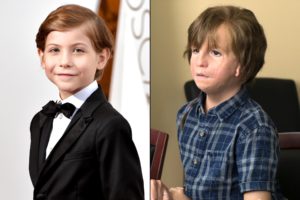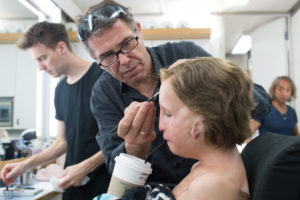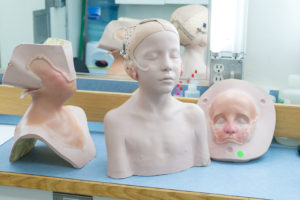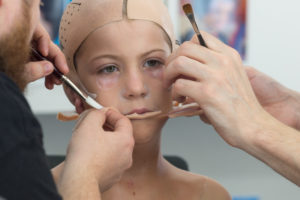
To bring the character of Auggie Pullman (a boy with severe facial deformities) to fruition in the film Wonder, makeup effects artist, Arjen Tuiten researched children with Treacher Collins syndrome. “Most of the time, they had a very similar look,” Tuiten stated. “Very distinguished. To create the illusion, I knew Auggie was going to need full prosthetics.”
Although Tuiten felt the character could be created with a makeup, the producers were understandably nervous about having to apply detailed work on Jacob Tremblay who played Auggie when he was just nine years old. “There was a lot of pressure,” Tuiten revealed. “I had moments when I thought, ‘What have I done?’ I needed to meet Jacob to get an energy off him—he was very down-to-earth.” Key to the challenge was simplifying the makeup application process. “At 3am one night, I thought of this wire system,” Tuiten remembered. “If we built a little helmet with a lock system and wire, we could pull down and I wouldn’t have to glue his eyes down for nine hours.” Based on his conception, Tuiten gave the helmet project to jack-of-all-trades prosthetics artist, Art Sakamoto. Simultaneously, Tuiten lifecasted Tremblay, then created the sculpture to establish the total makeup look. “We did three different sculpts,” Tuiten described. “I thought the prosthetic appliances would end at the breathing tube scar at the front of his throat, but we had to go all the way down: a shoulder piece with neck, chin and cheeks that slipped over his head.”
Though Auggie has a cleft palette in the script, giving him a nasal-labial lisp in his speaking, producing company Lions Gate chose not to include that aspect. “There was only so far we could go,” Tuiten confessed. Instead, Sakamoto created artificial teeth, which helped push Tremblay’s upper lip out, making the full makeup tortoise-like in profile.

Since Tuiten was mandated to do “anything to help cut makeup time,” he knew his “design had to be very smart.” During application, Robert Pandini, key hairstylist, would comb Tremblay’s hair back, after which Tuiten would very carefully put the helmet on. “The helmet served as a baldcap,” he said. “The undeveloped cartilage earlobes were attached to the helmet to also save time.” One unexpected element working with Tremblay was that the boy grew out of both the set of teeth and helmet from April 2016 to September of that year, when production wrapped. As a result, Tuiten and Sakamoto cut the helmet in the manner of an accordion, with Velcro added, to expand to fit Tremblay’s growing cranium.

Adding to the helmet was a front facial piece: a forehead with a nose and upper lip connected. Michael Nickiforek, a local Vancouver makeup artist, helped Tuiten apply the makeup on a daily basis. Eventually, the complete makeup application time was streamlined from 90 to 75 minutes, with a custom wig being the finishing touch. “We built the wig and designed the wigs here at the shop,” Tuiten detailed. “Robert Pandini maintained it on set, while I was focusing on the makeup. He also wears contact lenses to enlarge his irises to remove the white of the eye when you pull it down.”

As Tremblay’s helmet ran underneath the silicone prosthetics, Tuiten combed the wig aside to release his eyes with a lock mechanism during downtime, throughout 38 shooting days. “I am so amazed by him, such a little trooper and old soul,” Tuiten remarked.
Previously considered for an Oscar in preliminary rounds for his prosthetics work in Maleficent, Tuiten is now nominated for Wonder. “I’m extremely humbled and honored,” he said of the recognition by his peers. “I’ve had two surgeons email me saying they thought it was a real boy with Treacher Collins syndrome. In a way, that’s a great compliment, but it can also work against you!”





